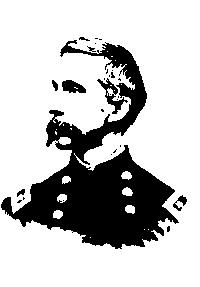On April 9, 1865, General Robert E. Lee, commander of the Confederate Army of Northern Virginia, surrendered to Ulysses S. Grant, commanding general of the Union Army, at Appomattox Court House in Virginia.
It was there, 150 year ago, that General Joshua Chamberlain honored those defeated Confederates in what is considered to be one of the most poignant scenes of the Civil War. Professor of History Patrick Rael writes of what Chamberlain’s salute to southern foes portended for the difficult period that followed.

Patrick Rael
On April 9, 1865, the bloodiest conflict ever fought in the western hemisphere ended, and a Bowdoin man was at the center of the action. Joshua Lawrence Chamberlain, the studious Brewer native who became a college professor, emerged as one of the finest civilian-soldiers of the Civil War.
If any aspect of Chamberlain’s service rivals his bayonet charge at Gettysburg for fame, it is the magnanimity he displayed to defeated Confederates at the surrender at Appomattox Court House. By the end of the war Chamberlain had become so well regarded that he was chosen to oversee the Confederate infantry’s formal transferal of arms on April 12.
In his memoir The Passing of the Armies (1915), Chamberlain recalled the moment vividly:
Before us in proud humiliation stood the embodiment of manhood: men whom neither toils and sufferings, nor the fact of death, nor disaster, nor hopelessness could bend from their resolve; standing before us now, thin, worn, and famished, but erect, and with eyes looking level into ours, waking memories that bound us together as no other bond.
As the infantrymen of Confederate General John B. Gordon filed past lines of Union soldiers to surrender their arms, Chamberlain did something special. Reasoning that “such manhood” deserved to be “welcomed back into a Union so tested and assured,” he ordered his men to shift their rifles from the “order – arms” position into the “carry” position.
Gordon, in his own memoir, remembered with gratitude this “soldierly salute to those vanquished heroes.” He viewed it as “a token of respect from Americans to Americans, a final and fitting tribute from Northern to Southern chivalry.” Neither was Gordon alone. Many Americans have praised Chamberlain’s actions since, as a Lincoln-esque gesture to help quickly reunite the shattered nation.

Joshua Chamberlain
Yet the speedy reconstruction promised by this moment of sectional reconciliation did not come to pass. The troubled decade that followed the great rebellion is seldom recalled with the fanfare we heap on the Civil War itself. But it was Reconstruction that ultimately resolved the issues that had triggered the conflict in the first place. What would be the fate of the planter class? Would federal power tame the might of the states? How far would be extended the protections of national citizenship? And what rights, if any, did freedom confer to the enslaved African Americans the war had emancipated?
Commemorating the surrender at Appomattox marks the end of the Civil War’s sesquicentennial. Yet this also begins the 150th commemoration of the difficult period that followed the war. Chamberlain was no less important after the war than he was during it. In the critical years of Reconstruction, he served four one-year terms as governor of a state that had reared a president and a vice president, and had offered the nation important generals and prominent national figures. His opinion mattered.
So what did his gesture at Appomattox portend for his view of the post-war world?
Though Chamberlain proved a popular candidate in Maine, his reconciliationist tendencies put him at odds with his own party. His post-war public statements pegged him as a moderate whose sympathies lay more with defeated rebels than with the “poor, surprised race” the war had emancipated. It was a time when former Confederates were sweeping back into southern statehouses. Disturbing reports of widespread abuses of the freedpeople began appearing in the national press and in the halls of Congress.
Chamberlain, though, argued that Reconstruction was “a work which can effectually be done through the best minds of the South” — a sentiment that seemed to exclude the possibility of black voting, and thus risked his party’s nomination. He quickly pre-empted the critical reactions of his Radical Republican colleagues by conceding that it was “absolute madness” to return Confederates to power and “turn our backs” on a slave population that had willingly offered the Union its military service. His about-face worked, and in 1866 he won his first gubernatorial race by a historic margin.
His flexibility on the issue, though, remained a constant feature of his politics. In 1879, in the aftermath of Reconstruction, Chamberlain renewed his defense of Confederate reinstatement, proclaiming that it was “folly” and “babyish weakness” to criticize the South for sending its “best minds” to Congress. In the political parlance of the day, Chamberlain proposed to “shake hands across the bloody chasm” and reunite with the noble enemies he had confronted on the battlefield.
While later generations have praised this impulse, it is well for us to remember who some of Chamberlain’s noble enemies were. Confederate General John B. Gordon, the recipient of Chamberlain’s largess at Appomattox, went on to become a leading figure in the Ku Klux Klan. Fellow Confederate generals such as Nathan Bedford Forrest and Edmund Pettus joined him, while others such as Wade Hampton adopted the Klan’s tactics if not its name.
These southern leaders launched an unprecedented campaign of white supremacist terror that ultimately succeeded in driving the Republican Party out of power in the South. In the worst campaign of extra-legal violence the county has ever known, the Klan and its followers invaded the homes of politically active or economically successful freedpeople, publicly whipped and assassinated Republican opponents, committed widespread fraud during elections, and engaged in pitched battles against legitimate state militias. This effectively nullified the guarantees of civil and political rights enacted in the 14th and 15th Amendments, leaving the freedpeople to the tender mercies of their former masters.
Chamberlain was not ignorant of this. His fellow Mainer, Adelbert Ames, who had commanded the 20th Maine before him, had enjoyed a ringside seat to Klan tactics when serving as the “carpetbag” governor of Mississippi. As Democratic paramilitary forces wrested control of the state in 1875, Ames pled to Chamberlain for aid: “The whole question south is that of the personal liberty and security of the negro. . . . You can have no idea of the true state of the case here. . . . We do hope the North will stand true to the rights of the colored man.” Alas, Chamberlain had no response.
Chamberlain’s actions on April 12, 1865, accurately presaged the approach he would take to national issues following the war. But while his memory is praised for his willingness to make peace with former opponents, his dedication to sectional reconciliation came with a price. To accommodate the forces that had risked all in launching a war to protect slavery often meant neglecting the interests of the very people on whose behalf the war had been fought. In the political algebra of Reconstruction, it proved difficult indeed to balance reunification of the country with securing the rights of the freed slaves.
Chamberlain frequently waxed rhapsodic about the unexpected virtues of war. “Fighting and destruction are terrible,” he wrote, “but are sometimes agencies of heavenly, rather than hellish, powers.” In the experience of battle, he believed, “some of the highest qualities of manhood are called forth — courage, self-command, sacrifice of self for the sake of something held higher.”
It is well that Chamberlain could find meaning and hope in an experience that led to the deaths of up to a million Americans. But the hope he encountered there — a quality of “fortitude, patience, warmth of comradeship” which “allies us to the highest personality” — did not seem to extend to all. That, perhaps, is the work he left to succeeding generations.
